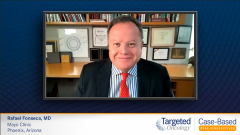
Evolving Treatment Options for Transplant-Ineligible Multiple Myeloma
Before closing out his discussion on transplant-ineligible multiple myeloma, Rafael Fonseca, MD, considers the future roles of CAR T-cell and bispecific antibody therapies.
Episodes in this series

Transcript:
Rafael Fonseca, MD: I really hope to see bispecifics and CAR [chimeric antigen receptor] T cells play a much more prominent role in the frontline therapy. The obvious [question]…is can something like CAR T cells replace stem cell transplant? It’s quite possible. In fact, we just had FDA approval for 1 of the CAR T cells for lymphoma that was tested head-to-head against transplant for that first relapse, and the data are stronger for the CAR T cells. We’re very excited about that, and why not? That could be the reality for multiple myeloma.
You could also imagine bispecifics coming in very strong in the post-transplant setting until that time. I can imagine a study in which patients who have procedural disease post-transplant even in the form of MRD [minimal residual disease] positivity only, for whom the administration of a bispecific could ultimately finish the job and result in curative therapy.
We’ve seen similar examples in other diseases. In ALL [acute lymphoblastic leukemia], patients who are treated with frontline blinatumomab plus dasatinib have excellent outcomes. Maybe that’s going to be the case for myeloma. Could there be a future in which a patient with multiple myeloma who has an 11;14 is treated with venetoclax and 1 of the bispecifics I mentioned? I hope for that, and I don’t think it’s far-fetched to think it’s a possibility.
The field of myeloma continues to move forward. Despite advances with bispecifics and CAR T cells, several other leads are being explored. One of them is iberdomide, a drug that has an interest that has a similar mechanism of action as IMiDs [immunomodulatory imide drugs]. They’re called CELMoDs. Dr [Sagar] Lonial presented the results for the expansion phases of the CC-220-MM-001 trial. These patients have been heavily pretreated as well too. The clinical trial they presented was on 107 patients with a medium of 6 prior therapies. This is very important because these drugs may be able to have more potency or perhaps even overcome resistance to prior human exposure.
The response rate they reported on this trial was 26%, which is not on par with what we’re seeing with bispecifics or other CAR Ts. Considering this is a purely oral regimen, it is of great attraction, particularly as we start to think about combinations of this regimen. This has been used and reported on patients with prior BCMA therapy. Unfortunately, with the current constructs and the strategies, patients experience relapse post–CAR T cells. Something like this could play an important role in that therapeutic.
People are looking at other things, like how we improve or perfect CAR T cells. One example is this other clinical trial, the CRB4-02, also known as bb21217. This is a BCMA targeting CAR T cells, but the cells are incubated in the presence of a PI3 kinase inhibitor. The idea is that can we enhance or enrich the production of memory like T cells so they would allow for a better response. The results are encouraging. We have to see in the long term whether this translates into benefits for our patients.
Speaking of novel approaches, another 1 would be to look at all these CAR T cells that target BCMA. I told you about a bispecific that targets GPRC5D. What about a CAR T that targets GPRC5D. Dr [Sham] Mailankody and Dr Eric Smith at Memorial Sloan Kettering [Cancer Center] presented the results of their GPRC5D CAR T cells. This was a smaller study. They had 12 patients, but they had a significant level of response: 10 of 12 patients responded, so that’s 83%. They had 3 very good partial responses and 2 stringent incomplete responses. Like other clinical trials, they report CRS [cytokine release syndrome]. It seems like the neurotoxicity was very rare. In fact, it was not reported at the time of the abstract submission.
This is very exciting. We’ve talked about 3 drugs that were not on our radar and that we’ll follow closely for further development.
Transcript edited for clarity.









































